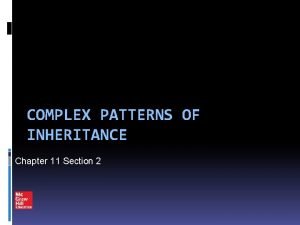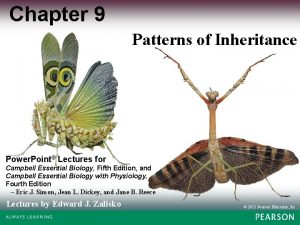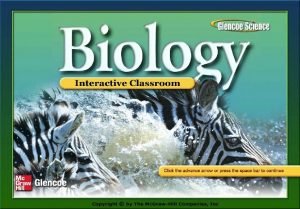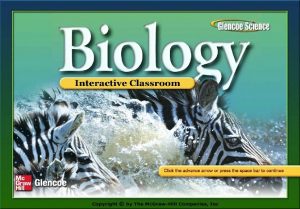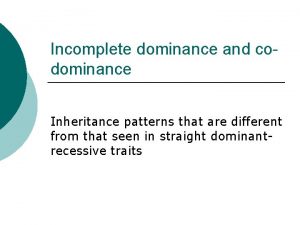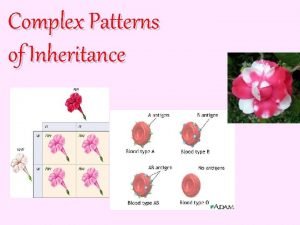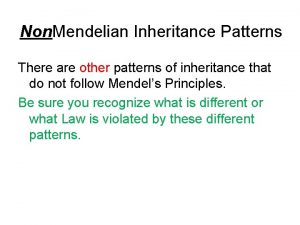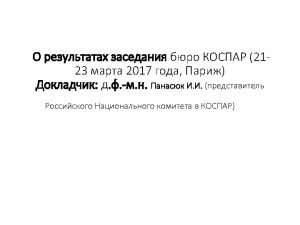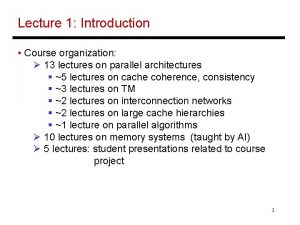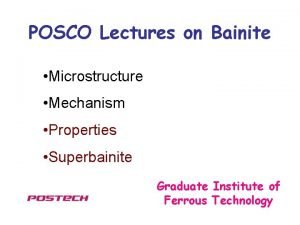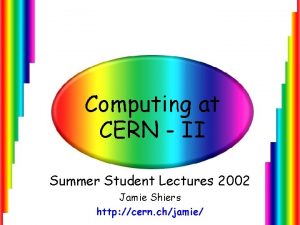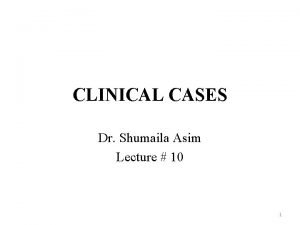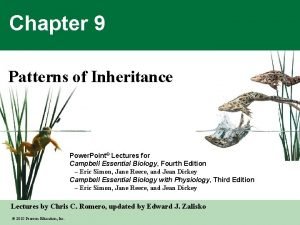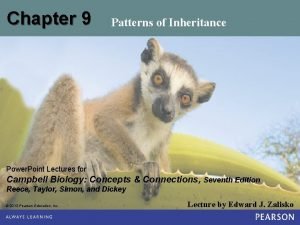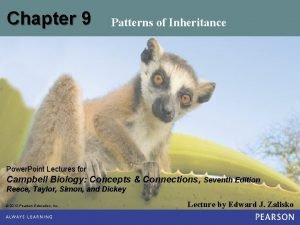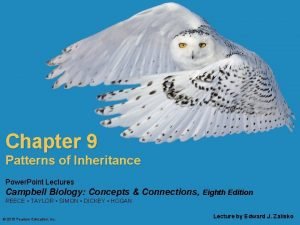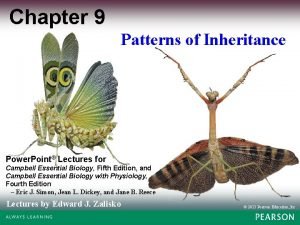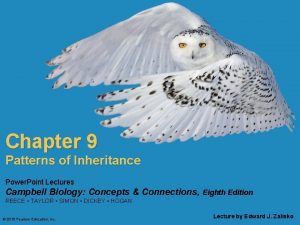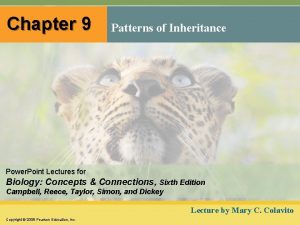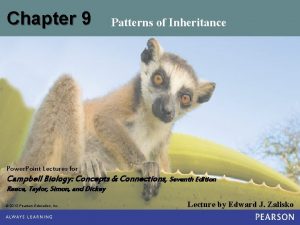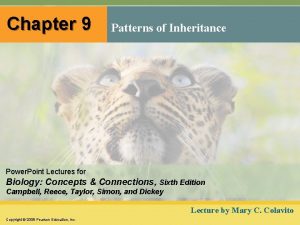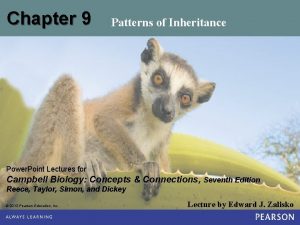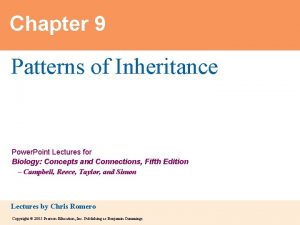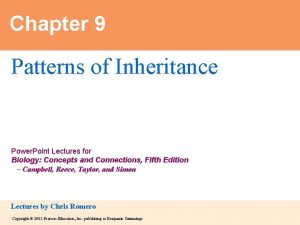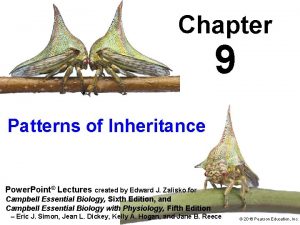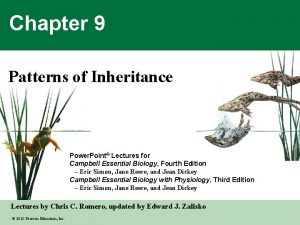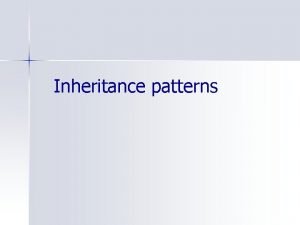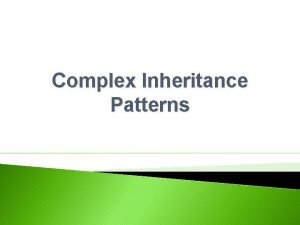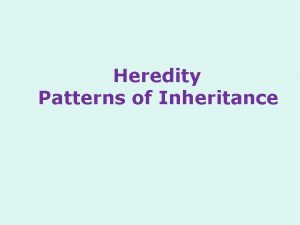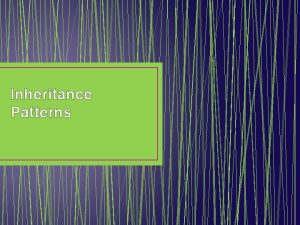Chapter 9 Patterns of Inheritance Power Point Lectures




























































- Slides: 60

Chapter 9 Patterns of Inheritance Power. Point® Lectures for Campbell Essential Biology, Fifth Edition, and Campbell Essential Biology with Physiology, Fourth Edition – Eric J. Simon, Jean L. Dickey, and Jane B. Reece Lectures by Edward J. Zalisko © 2013 Pearson Education, Inc.

Chapter 9: Concepts In this chapter we will learn 1. how genetic traits are passed from generation to generation and 2. how the behavior of the chromosomes account for these rules 3. Study different types of inheritance pattern 4. Predict the ratio of resulting offspring for a particular trait

Biology and Society: Our Longest-Running Genetic Experiment: Dogs • People have selected and mated dogs with preferred traits for more than 15, 000 years. • Over thousands of years, such genetic tinkering has led to the incredible variety of body types and behaviors in dogs today. • The biological principles underlying genetics have only recently been understood. © 2013 Pearson Education, Inc.

Labrador retriever puppies Figure 9. 0

HERITABLE VARIATION AND PATTERNS OF INHERITANCE • Heredity is the transmission of traits from one generation to the next. • Genetics is the scientific study of heredity. • Gregor Mendel (1822 -1884) “Father of Genetics ” – Worked in the 1860 s – first person to use something akin to the scientific method to observe and analyze patterns of inheritance – Deduced the fundamental principles of genetics.

The structure of a pea flower Mendel studied garden peas because they ü Are easy to grow ü Come in many readily distinguishable varieties of traits ü Are easily manipulated ü Can self-fertilize normally Petal Stamen (makes spermproducing pollen) Carpel (produces eggs) Figure 9. 2

In an Abbey Garden • Each of the characters Mendel studied occurred in two distinct forms. – A character is a heritable feature that varies among individuals (flower color). – A trait is a variant of a character (purple and white) – Each of the characters Mendel studied occurred in two distinct traits. • Mendel – created purebred (true-breeding ) varieties of plants and – crossed two different purebred varieties.

In an Abbey Garden • Hybrids are the offspring of two different purebred varieties. – The parental plants are the P generation. – Their hybrid offspring are the F 1 generation. – A cross of the F 1 plants forms the F 2 generation • Pure breeding or True breeding - varieties that produce identical offspring upon self fertilization • The cross-fertilization is referred as genetic cross

Mendel's technique for cross-fertilizing pea plants Removed stamens from purple flower. Mendel • created purebred varieties of plants and Parents (P) Carpel Purple White Stamens Transferred pollen from stamens of white flower to carpel of purple flower. Pollinated carpel matured into pod. Planted seeds from pod. • crossed two different purebred varieties Offspring (F 1) Figure 9. 3 -3

Mendel’s Law of Segregation • Mendel performed many experiments. • He tracked the inheritance of characters that occur as two alternative traits. • The results let him to formulate several hypothesis about inheritance

The seven characters of pea plants studied by Mendel Dominant Pod shape Flower color Purple White Flower position Seed color Seed shape Dominant Recessive Axial Terminal Yellow Green Round Wrinkled Pod color Inflated Recessive Constricted Green Yellow Tall Dwarf Stem length Figure 9. 4

Monohybrid Crosses • A monohybrid cross is a cross between purebred parent plants that differ in only one character (Flower color). • The offspring of these crosses showed how the traits were inherited P Generation (true-breading parents) Purple flowers F 1 Generation (1 st filial generation) White flowers All plants have 100% purple flowers Fertilization among F 1 plants (F 1 F 1) F 2 Generation (2 nd filial generation) 3 of plants 4 have purple flowers Blast Animation: Single-Trait Crosses 1 of plants 4 have white flowers

Monohybrid Crosses Mendel developed 4 hypotheses from the monohybrid cross: 1. There alternative versions of genes, the units that determine heritable traits called alleles. 2. For each character, an organism inherits two alleles, one from each parent. – An organism is homozygous for that gene if both alleles are identical. – An organism is heterozygous for that gene if the alleles are different.

Monohybrid Crosses 3. If two alleles of an inherited pair differ – The allele that determines the organism’s appearance is the dominant allele – The other allele “hidden”, which has no noticeable effect on the appearance, is the recessive allele 4. Gametes carry only one allele for each inherited character. – The two members of an allele pair segregate (separate) from each other during the production of gametes. – This statement is the law of segregation.

Monohybrid Crosses Do Mendel’s hypotheses account for the 3: 1 ratio he observed in the F 2 generation? • A Punnett square highlights - the four possible combinations of gametes and - offspring that result from each cross. • Geneticists distinguish between an organism’s physical appearance and its genetic makeup. - An organism’s physical traits are its phenotype (3 : 1 ratio) - An organism’s genetic makeup is its genotype (list of the organism’ genes and their exact DNA position) (1: 2: 1 ratio)

The law of segregation P Generation Genetic makeup (alleles) Alleles carried by parents MEIOSIS Gametes Purple flowers 2 n PP White flowers pp 2 n All p n All P n F 1 Generation (hybrids) Purple flowers All Pp 2 n Alleles segregate 1 P 2 Gametes Reginald Punnett (1875 - 1967) An explanation of Monohybrid results using a Punnett square F 2 Generation (hybrids) 1 p 2 Sperm from F 1 plant Eggs from F 1 plant P p PP Pp Pp pp P p Phenotypic ratio Genotypic ratio 3 purple : 1 white 1 PP : 2 Pp : 1 pp Figure 9. 6

Genetic Alleles and Homologous Chromosomes A gene locus is a specific location of a gene along a chromosome Homologous chromosomes have alleles (alternate versions) of a gene at the same locus. Gene loci Homologous chromosomes Dominant allele P a B P a b Recessive allele Genotype: PP Homozygous for the dominant allele aa Homozygous for the recessive allele Bb Heterozygous with one dominant and one recessive allele

Mendel’s Law of Independent Assortment • A dihybrid cross is the crossing of parental varieties differing in two characters. • Studied inheritance of pattern of two characters one at a time in a monohybrid ratio – seed color (yellow is dominant to green) – seed shape (round shape is dominant to wrinkled seed) • What would result from a dihybrid cross? Two hypotheses are possible: 1. Dependent assortment (two traits are inherited together) or 2. Independent assortment (alleles appear in all possible combinations)

Testing alternative hypotheses for gene assortment in a dihybrid cross (a) Hypothesis: Dependent assortment P Generation RRYY Gametes RY F 1 Generation rryy ry Rr. Yy (b) Hypothesis: Independent assortment RRYY Gametes RY rryy ry Rr. Yy Were the two characters transmitted to offspring as a package (capital letter staying together), or was each character inherited independently of each other (consider all possible combinations )?

(a) Hypothesis: Dependent assortment P Generation RRYY (b) Hypothesis: Independent assortment RRYY rryy Gametes RY ry F 1 Generation rryy ry Gametes RY Rr. Yy Sperm F 2 Generation 1 1 r. Y RY 4 4 Sperm 1 2 RY 1 ry 2 Eggs 1 r. Y 4 Rr. YY rr. YY Rr. Yy 1 Ry 4 RRYy Rr. Yy RRyy 1 ry 4 Predicted results (not actually seen) 1 ry 4 1 RY 4 RRYY Rr. YY RRYy Rr. Yy 1 2 RY Eggs 1 Ry 4 rr. Yy Rryy rryy Actual results (support hypothesis) Rr. Yy 9 16 Yellow round 3 16 Green round 3 16 1 16 Yellow wrinkled Green wrinkled

Mendel’s Law of Independent Assortment • Mendel’s dihybrid cross supported the hypothesis that each pair of alleles segregates independently of the other pairs during gamete formation. • Thus, the inheritance of one character has no effect on the inheritance of another. • This is the law of independent assortment. • Independent assortment is also seen in two hereditary characters in Labrador retrievers.

Blind dog Independent assortment of genes in Labrador retrievers Phenotypes Genotypes Blind dog Black coat, normal vision B_N_ Black coat, blind (PRA) B_nn Chocolate coat, normal vision bb. N_ Chocolate coat, blind (PRA) bbnn (a) Possible phenotypes of Labrador retrievers Mating of double heterozygotes (black coat, normal vision) Bb. Nn Blind Phenotypic ratio of offspring 9 black coat, normal vision 3 black coat, blind (PRA) Blind 3 chocolate coat, normal vision 1 chocolate coat, blind (PRA) (b) A Labrador dihybrid cross Figure 9. 9

Using a Testcross to Determine an Unknown Genotype • A testcross is a mating between – an individual of dominant phenotype (but unknown genotype) – a homozygous recessive individual Testcross B_ Genotypes bb Two possible genotypes for the black dog: Bb BB or Gametes B b Offspring Bb All black b Bb bb 1 black : 1 chocolate

The Rules of Probability • • • Mendel’s strong background in mathematics helped him understand patterns of inheritance. For each toss of the coin, the probability of heads is ½ every time – the outcome of any given toss is unaffected by what has happened on previous attempts (toss is an independent event). If 2 coins are tossed simultaneously, the outcome for each is independent, unaffected by the other coin. What is the chance that both coins land heads-up ? the probability of dual event is the product of the separate probabilities of the independent events – ½ x ½ = ¼ (The rule of multiplication states that the probability of a compound event is the product of the separate probabilities of the independent events). In the dihybrid cross of Lab dog, the genotype of the F 1 dogs fo coat color is Bb. What is the probability that a particular F 2 dog will have the bb genotype?

Segregation of alleles and fertilization as chance events F 1 Genotypes Bb female Bb male Formation of eggs Formation of sperm F 2 Genotypes Formation of gametes is like flipping a coin (Head or tail) Chance of having a head or a tail is ½ BB= 25%; bb= 25%; Bb=50% The rule of addition for heterozygote (Bb) ü Inside the table you add probabilities ½ + ½ = 1/4 1 2 Female gametes The rule of multiplication ü Multiply from the outside of the table to the inside Male gametes 1 2 B B 1 2 b B 1 4 ( 1 1) 2 1 2 b b 2 b B 1 4 b b 1 4 Figure 9. 11

Family Pedigrees Freckles RECESSIVE TRAITS – normal or – more common DOMINANT TRAITS • Mendel’s principles apply to the inheritance of many human traits. • Dominant traits are not necessarily Widow’s peak Free earlobe • Wild-type traits are – those seen most often in nature and No freckles Attached earlobe Straight hairline – not necessarily specified by Examples of inherited traits controlled dominant alleles by single gene

Family Pedigrees • A family pedigree – can deduce which trait is recessive – can also deduce the genotype of most of the people in pedigree – shows the history of a trait in a family and – allows geneticists to analyze human traits. © 2013 Pearson Education, Inc.

First generation (grandparents) Second generation (parents, aunts, and uncles) Third generation (brother and sister) Aaron Ff Betty Ff Evelyn Fred Gabe Hal FF ff ff Ff or Ff Kevin ff Female Male Attached Cletus ff Ina Ff Debra Ff Jill ff Lisa FF or Ff Female Male Free Figure 9. 13

Human Disorders Controlled by a Single Gene • Many human traits show simple inheritance patterns are controlled by single genes on autosomes (not on sex chromosomes )

1. Recessive Disorders • Most human genetic disorders are recessive. • Individuals who have the recessive allele but appear normal are carriers of the disorder. Suppose, 2 hetero carriers have a child. What is the probability that the child will be deaf? Parents Hearing Dd Offspring D D Sperm d DD Hearing Dd Hearing (carrier) dd Deaf Eggs d

Recessive Disorders • Cystic fibrosis – is the most common lethal genetic disease in the USA – is caused by a recessive allele carried by about one in 25 people of European ancestry • Prolonged geographic isolation of certain populations can lead to inbreeding, the mating of close relatives. – It is relatively unlikely that two carriers of a rare allele will meet and mate. – Inbreeding increases the chance of offspring that are homozygous for a harmful recessive trait.

2. Dominant Disorders Some human genetic disorders are dominant. • Achondroplasia is a form of dwarfism. – The homozygous dominant genotype causes death of the embryo. – Only heterozygotes have this disorder. – Also, have 50% chance of passing this condition to children • Huntington’s disease, which leads to degeneration of the nervous system, does not begin until middle age. Achondroplasia, a dominant trait

Genetic Testing • Today many tests can detect the presence of diseasecausing alleles. • Most genetic testing is performed during pregnancy. – Amniocentesis collects cells from amniotic fluid. – Chorionic villus sampling removes cells from placental tissue. • Genetic counseling helps patients understand the results and implications of genetic testing.

VARIATIONS ON MENDEL’S LAWS Some patterns of genetic inheritance are not explained by Mendel’s laws. Additional tests have revealed some special cases of genetic inheritance : ü Incomplete dominance ü Multi-allelic dominance ü Single genes affecting multiple traits (pleiotropy) ü Polygenic inheritance

Incomplete dominance in Plants and People Snapdragons F 1 hybrids have an appearance in between the phenotypes of the two parents. This is the result of incomplete dominance. Pure red and pure white snapdragons produce all-pink offspring (mixed color). Two alleles produce three phenotypes ? Differences & similarities with the Mendelian genetics? P Generation White rr Red RR Gametes R r F 1 Generation Pink Rr 100% Gametes F 2 Generation 1 2 R Eggs 1 r 2 1 1 R 2 r 2 Sperm 1 1 R 2 r 2 RR Rr Rr rr

Incomplete dominance in Plants and People b) Hypercholesterolemia – is characterized by dangerously high levels of cholesterol in the blood. – is a human trait that is incompletely dominant. – Heterozygotes have blood cholesterol levels about twice normal. – Homozygotes have blood cholesterol levels about five times normal.

PHENOTYPE GENOTYPE Incomplete dominance in Plants and People HH Homozygous for ability to make LDL receptors Hh Heterozygous hh Homozygous for inability to make LDL receptors LDL receptor Cell Normal Mild disease Severe disease Make half of the Receptors Low diet in cholesterol can alleviate Unable to excess cholesterol Low diet in cholesterol + something else Figure 9. 19

ABO Blood Groups: An Example of Multiple Alleles and Codominance • The ABO blood groups in humans are an example of multiple alleles and Codomiance. • The immune system produces blood proteins called antibodies that bind specifically to foreign carbohydrates. • If a donor’s blood cells have a carbohydrate (A or B) that is foreign to the recipient, the blood cells may clump together, potentially killing the recipient. • The clumping reaction is the basis of a blood-typing lab test. • The human blood type alleles IA and IB are codominant, meaning that both alleles are expressed in heterozygous individuals who have type AB blood.

2. Multiple allele and Codominance • There are three common alleles for ABO blood type – Allele IA for the ability to make substance A – Allele IB for the ability to make substance B – Allele i for the ability to make neither of the substance • Four blood groups were made from 3 different alleles – type A : IA IA homozygote dominant for A or IAi heterozygote for A – type B : IB IB homozygote dominant for B or IBi heterozygote for B – type AB : IA IB heterozygote for A and B; codominance – type O : ii (recessive) • The human blood type alleles IA and IB exhibit codominance: Both alleles are expressed in the phenotype.

Multiple Alleles for the ABO blood group Blood Group Genotypes (Phenotype) A IAIA or IAi B IBIB or IBi AB IAIB O ii Red Blood Cells Antibodies Present in Blood Reactions When Blood from Groups Below Is Mixed with Antibodies from Groups at Left A B AB O Carbohydrate A Anti-B Carbohydrate B Anti-A Universal recipient — Universal donor Anti-A Anti-B I = for immune factor can be either A or B; IA = allele A; IB = allele B i = absence of the immune factor IAIB is codominance; IA and IB are two codominant alleles Three alleles give four phenotypes

Pleiotropy and Sickle-Cell Disease • Pleiotropy is when one gene influences several characters. • Sickle-cell disease – exhibits pleiotropy, – results in abnormal hemoglobin proteins, and – causes disk-shaped red blood cells to deform into a sickle shape with jagged edges. many others things can happen: red blood cells tend to breakdown or clump easily , and trhis may result in spleen damage

Individual homozygous for sickle-cell allele Sickle-cell (abnormal) hemoglobin Colorized SEM Abnormal hemoglobin crystallizes into long flexible chains, causing red blood cells to become sickle-shaped. Sickled cells can lead to a cascade of symptoms, such as weakness, pain, organ damage, and paralysis. Figure 9. 21

4. Polygenic Inheritance • Polygenic inheritance is the additive effects of two or more genes on a single phenotype. P Generation aabbcc (very light) AABBCC (very dark) Aa. Bb. Cc F 1 Generation F 2 Generation 1 8 1 8 Sperm 1 1 8 8 1 8 1 8 Fraction of population 1 8 1 8 1 Eggs 8 1 8 1 8 A model for polygenic inheritance of skin color. 1 64 6 64 15 64 20 64 15 64 6 64 1 64 Skin pigmentation

short allele tall allele P Generation aabbcc (very short) AABBCC (very tall) F 1 Generation Aa. Bb. Cc (medium height) Sperm F 2 Generation 1 8 Aa. Bb. Cc (medium height) 1 8 1 8 20 64 Fraction of population 1 8 Eggs 1 8 1 8 1 8 15 64 6 64 1 64 Very short 1 64 6 64 15 64 20 64 15 64 6 64 Adult height Very tall 1 64 Figure 9. 22

Summary: Variations in Mendel’s law a) incomplete dominance Dominant phenotype (RR) b) Codominance Recessive phenotype (rr) Intermediate phenotype (incomplete dominance) (Rr) c) Pleiotropy Single gene Multiple traits (e. g. , sickle-cell disease) d) Polygenic inheritance Multiple genes Single trait (e. g. , skin color) Blood Group Genotypes Red Blood Cells (Phenotype) Carbohydrate A IA IA A or IA i Carbohydrate B IBIB B or IBi AB IA IB O ii

The Role of Environment • Many human characters result from a combination of heredity and environment. • Only genetic influences are inherited.

Chromosomal Basis of Inheritance • The chromosome theory of inheritance states that – Genes are located at specific positions on chromosomes – The behavior of chromosomes during meiosis and fertilization accounts for inheritance patterns • It is chromosomes that undergo segregation and independent assortment during meiosis and thus account for Mendel’s laws.

The chromosomal basis of Mendel's laws P Generation Round-yellow seeds (RRYY) r y Y Y Wrinkled-green seeds (rryy) R R y MEIOSIS r FERTILIZATION Gametes y R Y F 1 Generation R r MEIOSIS I Law of Segregation: Follow the long chromosomes (carrying R and r) taking either the left or right branch. The R and r alleles segregate in anaphase I of meiosis. Gametes Y Fertilization recombines the r and R alleles at random. F 2 Generation y Law of Independent Assortment: Follow both the long and the short chromosomes. MEIOSIS Metaphase I (alternative arrangements) r y R r Y y y Y Y R All round-yellow seeds (Rr. Yy) Y R Only one long chromosome ends up in each gamete. r R Y y Y r 1 r. Y 4 FERTILIZATION AMONG THE F 1 PLANTS 9 : 3 They are arranged in either of two equally likely ways at metaphase I. R r 1 ry 4 R r Y y r r 1 4 RY Metaphase II r : 1 They sort independently, giving four gamete types. y y R R 1 Ry 4 Fertilization results in the 9: 3: 3: 1 phenotypic ratio in the F 2 generation.

Linked Genes • Are located close together on the same chromosome • May be inherited together • Using the fruit fly Drosophila melanogaster, Thomas Hunt Morgan determined that some genes were linked based on the inheritance patterns of their traits.

Thomas Morgan’s experiment and results Dihybrid testcross Inconsistency with Mendel Principles Gg. Ll heterozygote from F 1 Gametes GL and gl Gray body, long wings (wild-type) Black body, short wings (mutant) Gg. Ll ggll Female Male Results ggll recessive Gametes GL and gl Offspring Gray-long Gg. Ll Black-short ggll Gray-short Ggll Black-long gg. Ll Offspring Gg. Ll & ggll But this is not what we observe 965 944 Parental phenotypes 83% 206 185 Recombinant phenotypes 17% Figure 9. 25 -2

Genetic Recombination: Crossing Over • Crossing over can – Separate linked alleles – Produce gametes with recombinant chromosomes – Produce offspring with recombinant phenotypes A B a b AB Parental gametes ab Pair of homologous chromosomes Crossing over A b a B Recombinant gametes

Explaining the unexpected results from the dihybrid testcross Gg. Ll (female) GL gl gl gl ggll (male) Crossing over GL g. L Gl gl gl Sperm Parental gametes Recombinant gametes Eggs FERTILIZATION Offspring GL gl Gl g. L gl gl Parental Recombinant

Linkage Maps • The percentage of recombinant offspring among the total is called the recombination frequency. • Alfred H. Sturtevant, a student of Morgan, developed a method for mapping gene loci, which resulted in the creation of linkage maps. – A diagram of relative gene locations on a chromosome is a linkage map. Chromosome g c 17% Using crossover data to map genes 9. 5% 9% Recombination frequencies l

Sex Determination in Humans Nearly all mammals have a pair of sex chromosomes designated X and Y. Males have an X and Y. Females have XX. Female 44 XY Somatic cells 44 XX X Y Colorized SEM 22 X 22 Y Sperm 22 X 44 XY Female Offspring Egg Male

Sex Chromosomes and Sex-Linked Genes • Any gene located on a sex chromosome is called a sexlinked gene. – Most sex-linked genes are found on the X chromosome. • Sex chromosomes influence the inheritance of certain traits. Red-green color blindness is – a common human sex-linked disorder and – caused by a malfunction of light-sensitive cells in the eyes. A test for red-green colorblindness

Inheritance of colorblindness, a sex-linked recessive trait XNXN XNXn Xn Y XNY Sperm Xn XNXn Sperm XN Y Sperm Xn Y Eggs XN XNXn XNY Eggs XN XN XNXn XNY Xn XNXn Xn. Y Xn (a) Normal female colorblind male Key Unaffected individual Xn Y (b) Carrier female normal male Carrier Colorblind individual Y XNXn XNY Xn Xn Xn Y (c) Carrier female colorblind male

Sex-Linked Genes Hemophilia – Is a sex-linked recessive blood-clotting trait that may result in excessive bleeding and death after relatively minor cuts and bruises – Has plagued royal families of Europe Albert Queen Victoria Alice Louis Alexandra Czar Nicholas II of Russia Alexis

The Process of Science: What Is the Genetic Basis of Coat Variation in Dogs? • Observation: Dogs come in a wide variety of physical types. • Question: What is the genetic basis for canine coats? • Hypothesis: A comparison of genes of a wide variety of dogs with different coats would identify the genes responsible. • Prediction: Mutations in just a few genes account for the coat appearance. • Experiment: Compared DNA sequences of 622 dogs from dozens of breeds. • Results: Three genes in different combinations produced seven different coat appearances, from very short hair to full, thick, wired hair.

Smooth versus wired fox terrier Figure 9. 17

Summary
 Section 2 complex patterns of inheritance
Section 2 complex patterns of inheritance A gene locus is
A gene locus is Chapter 11 section 1 basic patterns of human inheritance
Chapter 11 section 1 basic patterns of human inheritance Chapter 11 section 1 basic patterns of human inheritance
Chapter 11 section 1 basic patterns of human inheritance Chapter 9 patterns of inheritance
Chapter 9 patterns of inheritance Power system lectures
Power system lectures Codominant inheritance patterns
Codominant inheritance patterns Complex patterns of inheritance
Complex patterns of inheritance Mendelian pattern of inheritance
Mendelian pattern of inheritance Power triangle diagram
Power triangle diagram Informsu
Informsu Point point power
Point point power Dating patterns since the 1960s are
Dating patterns since the 1960s are Eclat algorithm
Eclat algorithm Rick trebino
Rick trebino Neonatology lectures
Neonatology lectures Data mining lectures
Data mining lectures Advanced medicinal chemistry
Advanced medicinal chemistry Uva ppt template
Uva ppt template Ludic space
Ludic space Step wise project planning
Step wise project planning Cell and molecular biology lectures
Cell and molecular biology lectures Radio astronomy lectures
Radio astronomy lectures Dr sohail lectures
Dr sohail lectures Utilities and energy lectures
Utilities and energy lectures Introduction to web engineering
Introduction to web engineering How to get the most out of lectures
How to get the most out of lectures Frcr physics lectures
Frcr physics lectures Heel effect
Heel effect Introduction to recursion
Introduction to recursion Blood physiology guyton
Blood physiology guyton Aerodynamics lecture
Aerodynamics lecture Theory of translation lectures
Theory of translation lectures Theory and practice of translation lectures
Theory and practice of translation lectures Theory of translation lectures
Theory of translation lectures Digital logic design lectures
Digital logic design lectures Jim kurose gaia
Jim kurose gaia Hegel classical art
Hegel classical art Nuclear medicine lectures
Nuclear medicine lectures Cs106b lectures
Cs106b lectures Cdeep lectures
Cdeep lectures Oral communication 3 lectures text
Oral communication 3 lectures text C programming and numerical analysis an introduction
C programming and numerical analysis an introduction Haematology lectures
Haematology lectures Bureau of lectures
Bureau of lectures Trend lectures
Trend lectures Theory of translation lectures
Theory of translation lectures Reinforcement learning lectures
Reinforcement learning lectures 13 lectures
13 lectures Reinforcement learning lectures
Reinforcement learning lectures Bba lectures
Bba lectures Medical emergency student lectures
Medical emergency student lectures Hematology medical student lectures
Hematology medical student lectures Stratog online lectures
Stratog online lectures Bhadeshia lectures
Bhadeshia lectures Ota resident lectures
Ota resident lectures Comsats virtual campus lectures
Comsats virtual campus lectures Hugh blair lectures on rhetoric
Hugh blair lectures on rhetoric Cern summer student lectures
Cern summer student lectures Pathology lectures for medical students
Pathology lectures for medical students Dr asim lectures
Dr asim lectures
